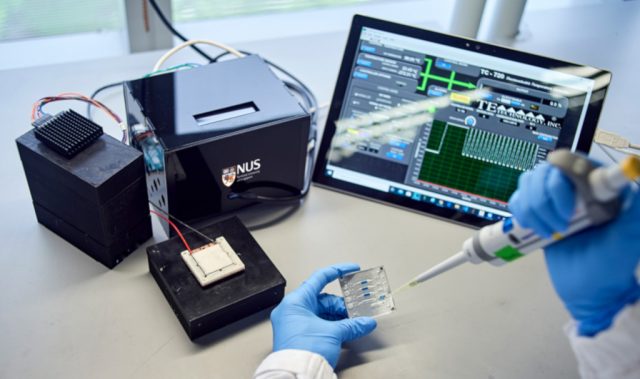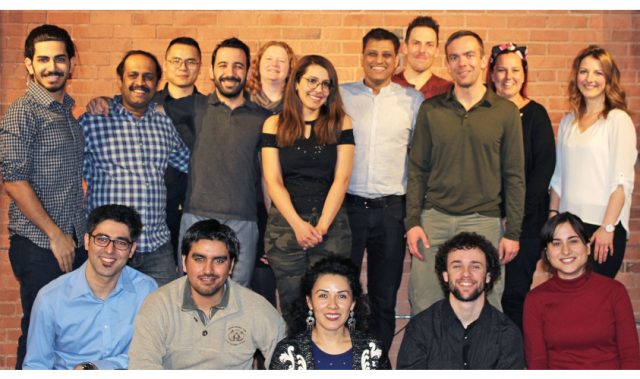
AsianScientist (Jun. 7, 2019) – When Wilhelm Röntgen, professor of physics at the University of Würzburg in Germany, accidently discovered X-rays at the end of the 19th century, he helped unlock the black box of the human body. Without having to take a scalpel to the skin, doctors could now look inside living people, learning about organs in normal and diseased states.
But simply being able to see a problem inside the body is not enough—the next logical step is intervention, and for that, surgery may be necessary. For years, surgeons accessed the internal organs by making large incisions that not only delayed patient recovery, but also put patients at greater risk of complications. Fortunately, with advances in medical imaging methods and miniaturized surgical devices, minimally invasive procedures are becoming increasingly commonplace, wherein surgeons can operate via an incision no larger than a pencil point.
Empowering doctors to perform complex, minimally invasive procedures more efficiently is Philips’ suite of innovative medical technologies. A frontrunner in the field of image guided therapy, Philips brings together the latest developments in medical imaging systems and devices that go into the body to help doctors see clearly and treat optimally.
“The combination of medical imaging and devices is really where the sum equals more than the individual components, and Philips is unique in being able to provide that integral solution,” said Mr. Bert van Meurs, Chief Business Leader, Image Guided Therapy, Philips.
Flexing the innovation muscle
Pushing the frontiers of image guided therapy is the Philips Azurion 7 C20 with FlexArm (Azurion with FlexArm), a revolutionary system that allows medical teams to perform real-time imaging across a whole patient in 2D and 3D. Developed in close consultation with pioneering surgeons and medical teams at top institutions around the world, the Azurion with FlexArm takes into consideration the intricacies and ergonomics of hybrid operating rooms to optimize procedures around the patient.
Given the limited space inside hybrid operating rooms, the physical footprint of image guided therapy systems matters significantly. Hence, the Azurion with FlexArm is ceiling mounted and has an 8-axis flexible arm, creating space around the operating table and giving the medical team unprecedented access to the patient from various positions, without compromising image quality.
“Previously, staff in the operating room had to work themselves around the imaging system. That’s not the way it should be. With the FlexArm, the system works around us,” said Dr. Atul Gupta, Chief Medical Officer, Image Guided Therapy, Philips. Dr. Gupta shared that 88 percent of physicians who spent 20 minutes practicing FlexArm and table positioning agreed that the FlexArm would reduce staff and equipment movement during procedures.
In addition, the reach and maneuverability of the FlexArm reduces the need to move the patient to obtain the optimal imaging position. The Image Beam Rotation feature of the Azurion with FlexArm also automatically rotates the image beam so that it remains aligned with the patient even as the FlexArm is moved. This eliminates the need to re-center the image each time the FlexArm takes up a new position.

Photo credit: Philips
An axis of excellence
Beyond enhancing the imaging capabilities of the Azurion system, Philips also upgraded the user interface for the Azurion with FlexArm, making it more intuitive and easier for clinicians to use in the hybrid operating room. “You can create the best technology in the world, but if it’s difficult to use, it never gets used,” said Mr. van Meurs. In the medical setting, poor usability could even compromise the quality of treatment.
Inspired by the controllers built for the gaming industry, engineers at Philips developed the Axsys intelligent motion control system and the Axsys controller for the Azurion with FlexArm. Simply by pushing a joystick or rotating it on its axis, clinicians can perform transverse or rotational movements to image the extended arms of a patient—important during procedures involving radial artery access from the wrist area—and various parts of a patient’s torso.
The predictable and precise movements of the FlexArm, initiated by the Axsys controller, minimize disturbances and allow consistent visualization throughout complex procedures.
Furthermore, should surgeons elect to perform open surgery in the event of sudden changes or complications in the patient, the Axsys controller can quickly send the Azurion with FlexArm into a standby position, saving precious seconds in a medical emergency.
A vision for the future
Completing the suite of innovations built into the Azurion with FlexArm is software that allows surgeons to input presets for a range of procedures. This allows different medical teams to switch between surgical and endovascular procedures, cardiac and peripheral procedures or endovascular and orthopedic surgeries in a hassle-free manner, within the same hybrid operating room. The presets not only save time, but also ensure greater consistency of treatment and reduce the likelihood preparation errors.
Cumulatively, these powerful new features of the Azurion with FlexArm help Philips achieve the quadruple aim of better health outcomes for patients, improved patient experience, improved staff experience and lower cost of care. “We treat 28 million patients a year in conjunction with physicians that use our image guided therapy systems or devices,” Dr. Gupta explained. “That’s one patient being treated every single second.”
But Philips is not resting on its laurels—it is working with Microsoft to combine Philips’ Azurion platform with the Microsoft HoloLens 2 mixed reality computing platform as a concept for the operating room of the future. The Philips and Microsoft augmented reality concept brings live imaging and other sources of vital data currently displayed on large 2D screens into a 3D holographic augmented reality environment that can be ergonomically, easily and intuitively controlled by the physician. The concept is being used to gather further clinical insights to support the development of future commercially-available augmented reality solutions for use in image-guided procedures.
“This could become the standard for image guided therapy ten years from now, but we’re already working on it today to continuously be ahead of the curve, and to focus on achieving the ambitions of the healthcare quadruple aim: better health outcomes, a lower cost of care, and an improved experience for both patients and staff.” Mr. van Meurs concluded.
This article is intended for healthcare professionals only. The content may contain references to specific Philips products and services that may not be (readily) available in a particular country. Any such reference does not imply or warrant that any such products or services shall be available at any time in any particular country. Please contact your local Philips business contact for further information.
Asian Scientist Magazine is a media partner for the launch of Philips Azurion 7 C20 with FlexArm.
———
Copyright: Asian Scientist Magazine; Photo: Philips.
Disclaimer: This article does not necessarily reflect the views of AsianScientist or its staff.












